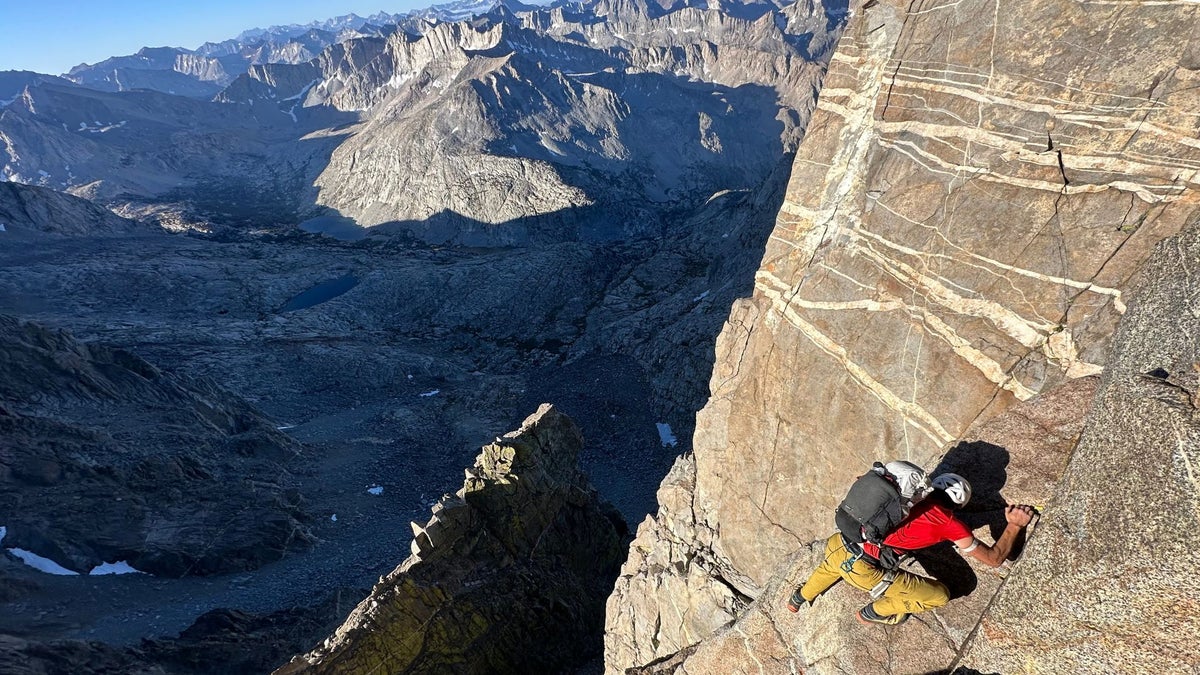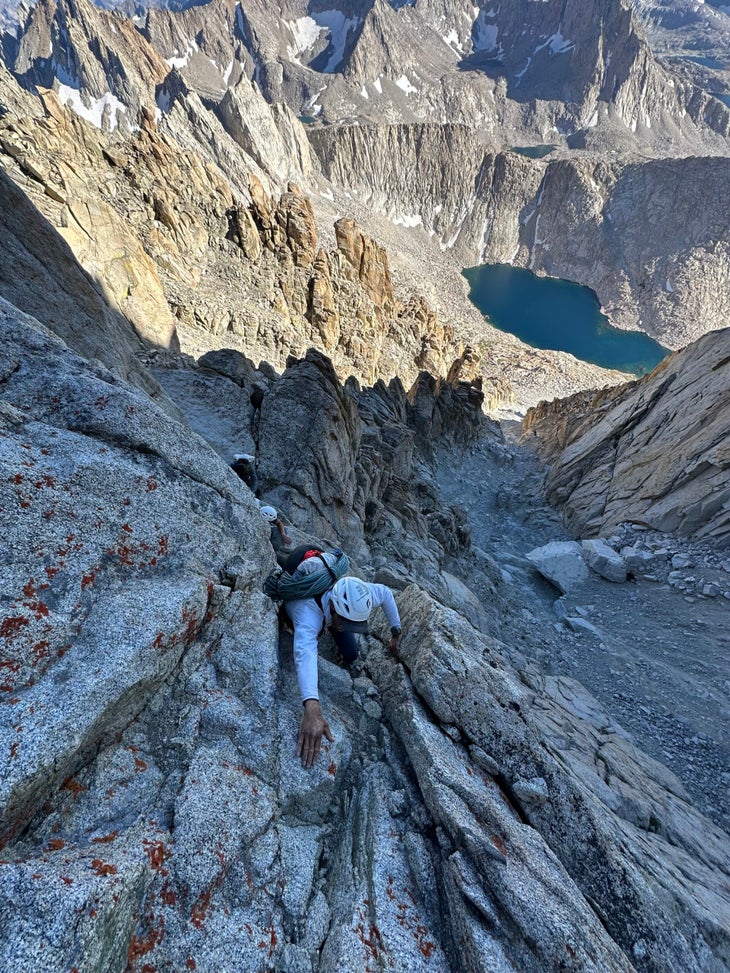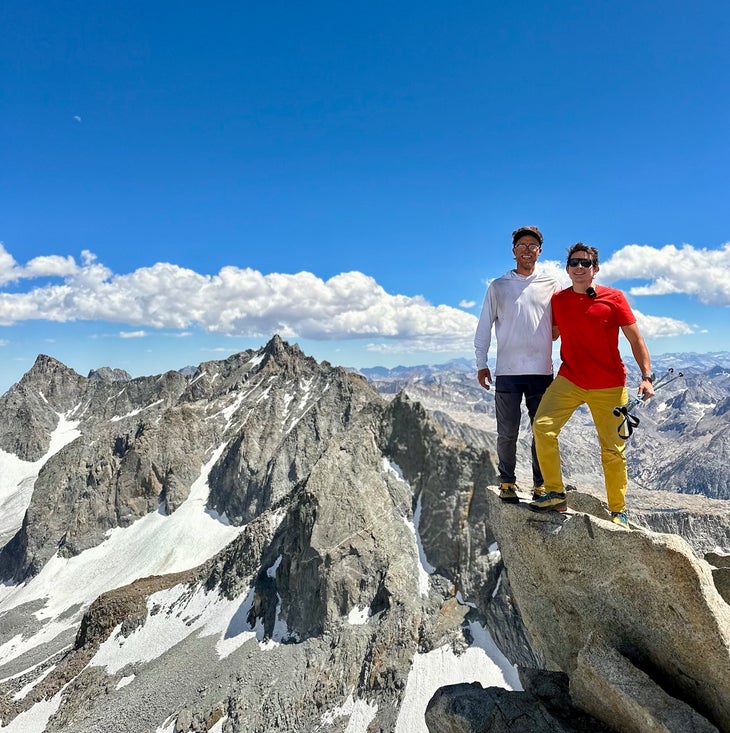
When I spoke with Tanner Wanish after he and Michael Vaill finished the Goliath Traverse (5.9; 80,000ft) on Monday evening, the vibe was less “excited victor” than it was “lucky survivor.” “I’m happier to be done with it than I am to have done it,” Wanish said. Over nine days beginning on July 27, Wanish and Michael Vaill made the second ascent of Vitaliy Musiyenko’s mammoth solo enchainment of 60-plus peaks in the High Sierras.
Wanish and Vaill are best known for the “Yosemite Quad,” a sub-24-hour linkup of four of the most iconic faces in Yosemite Valley: El Capitan, Mt. Watkins, Half Dome, and Washington Column. But when the pair completed the Quad last fall, they were cool as cucumbers: “We just had a good day out climbing,” Vaill told me at the time.
The Goliath was another story. “In terms of output, maybe this would be like doing the Quad every other day for eight days,” Wanish said. “It’s just egregiously more challenging. We covered a similar vertical distance (~10,000 feet) every day on Goliath as on the Quad, but here it’s unroped, on loose rock in the alpine, with 25 pounds of gear on your back, not knowing where you’re going to sleep, where you’re going to get water. It was overwhelming.”

The Goliath is essentially a 32-mile backpacking trip along a tightrope in the sky, where a single misstep would prove fatal. The route, which begins at Taboose Pass in the south and ends at Paiute Pass in the north, follows exposed and often loose fifth class rock—largely at elevations between 13,000 and 14,000 feet—along the undulating spine of the Sierra Crest. (Musiyenko wrote about the climb for a 2022 print feature in Climbing. A detailed map of his route is also available in his report for the American Alpine Journal.)
For Musiyenko, the project was intended less as a formal route for others to repeat and more a personal exploration of style and raw commitment. “For me, what became the Goliath Traverse was a test, and an attempt to get as close as I could to the limit of my own mental strength [and] fitness,” said Musiyenko, who completed Goliath unsupported. When I texted with him over the weekend, a couple of days before Wanish and Vaill finished their ascent, Musiyenko admitted that he “never imagined Goliath would be something other people would be interested in repeating. In a way, it is exciting, but I also would feel completely devastated if someone got hurt.” He added, “I’d like to make sure the audience understands this route is not anything that should become popular.”
Wanish had wanted to repeat Goliath since Musiyenko established the line in 2021. “I remember watching Vitaliy do this [on social media], and just being like, ‘What the fuck is this guy doing?’” he recalled. “Because he didn’t say where he was going. He just was posting updates on his social media: ‘I made it here,’ and ‘I made it here.’ He just kept going, and going, and going for eight days. It rocked my world. It was the craziest thing I’d ever seen.” (Musiyenko and Wanish) have since become close friends and climbing partners.) Initially, Wanish said he planned to go solo on Goliath, but eventually convinced Vaill to come along. The duo spent the last six months training like mad to make it happen.

For Wanish and Vaill, the second ascent wasn’t formed from a desire to match (or outdo) a previous effort, but to test themselves on their own terms. They did not follow Musiyenko’s style—alone and without a cache. Instead, they stashed supplies at Bishop Pass, roughly halfway through the traverse, and also spent a full day resting there. “The goal was just to complete this thing,” Wanish said, laughing. “To frame it as an FKT attempt or whatever would be psychotic.”
Wanish had traversed some of Goliath’s terrain before, including the popular Thunderbolt to Sill Traverse, a short but technical enchainment of five 14ers, and the Evolution Traverse, an eight-mile line rimming the Evolution Basin, but said “around 90% of this terrain was new for both of us.” He and Vaill initially planned to take an extra month to recon sections of the ridge, but Wanish said Musiyenko advised them against that, because it might psych them out. “He was like, ‘Dude, you might get a little bit of help there, but overall, it’s going to be an enormous amount of work, and it’s probably going to stress you guys out more to know what’s coming and to have to repeat some of those sections.’”
The pair brought a 60-meter 6-millimeter rope and used it for about a dozen rappels, but did all of their climbing unroped. Aside from a single rainy night, the weather was sublime, and nothing objectively bad happened (there was no near-miss with rockfall, no one took any falls), but it was still nine days of high consequence climbing. “There’s at least a couple of days where you’re in fatally consequential terrain for six to eight hours, straight,” Wanish said. “It’s hard to stay locked in for that long, that many days in a row. It was mentally exhausting.”
Wanish said that the Goliath was certainly the hardest climbing objective either he or Vaill had ever completed, by a significant margin, but he seemed to have trouble deciding whether he felt proud he’d done it, or ashamed of the risk he’d put himself through by free soloing so much terrain. “I’m really proud of our performance,” he explained, “but also a large degree of it felt like luck or chance.” He was overwhelmingly grateful to Musiyenko, “for having had the vision and sheer grit to open this,” but was clearly glad Goliath was in the rearview. “It was a good objective for us, for what we were looking for,” he said, “but having done it, I would not recommend this to anybody else, unless you’re looking for a life-changing experience.”

Wanish is a combat veteran, an ex-Navy SEAL, so he has no shortage of experience managing danger, and he admitted that the Goliath irrevocably “changed my perspective on risk in the mountains.” Wanish said that while overcoming fear and managing risk is one of the hallmark rewards of climbing—as with almost all adventure sports—some of the Goliath felt too much like a dice roll. “Danger can amplify purpose or meaning in the mountains,” he said. “You can tell yourself, ‘Oh, this is more meaningful, because I put myself out there and survived. But the Goliath felt like it had a disproportionate degree of luck built into it, rather than skill.”
Wanish placed much of his success, both physically and mentally, on his bombproof partnership with Vaill. The men have similar levels of risk tolerance, and although morale fluctuated throughout their nine days on the traverse, but when one was down, the other managed to boost his partner up (usually with a hefty dose of classic rock, like The Rolling Stones and Led Zeppelin). “If morale starts dropping and we’re both feeling sorry for ourselves, we put some music back on and it turns things around.”

On some days, both hit a wall simultaneously. Wanish said at those points, each put on a brave face for the other. “We had to artificially inject some ‘fake stoke’ sometimes,” he said. “When we felt mentally drained, we made a real effort to be vocally joyous, singing and hollering. If you can fake it long enough, eventually that stoke kicks in and becomes real.”
The post Want to Try the Goliath Traverse? Everyone Who Has, Says: “Don’t” appeared first on Climbing.